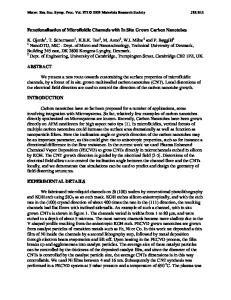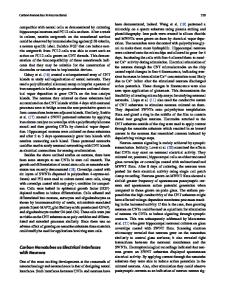Formation of boron carbonitride nanotubes from in situ grown carbon nanotubes for space applications
- PDF / 300,780 Bytes
- 6 Pages / 612 x 792 pts (letter) Page_size
- 60 Downloads / 373 Views
NN11.9.1
Formation of boron carbonitride nanotubes from in situ grown carbon nanotubes for space applications F. Piazza, J.E. Nocua, A. Hidalgo, J. De Jesús, R. Velázquez and G. Morell1 Department of Physics, University of Puerto Rico San Juan, PO Box 23343, Puerto Rico 00931 1 Department of Physical Sciences, University of Puerto Rico, San Juan, PO Box 23323, Puerto Rico 00931 ABSTRACT Boron carbonitride nanotubes (BCNNTs) were grown with high yield by arc discharge without catalyst particles or pre-grown template nanostructures. Two types of nanotubes (NTs) were formed: thin NTs with diameters of 10-15 nm and thick NTs with diameters of 25-50 nm, all multiwall. Transmission electron microscopy, electron energy loss spectroscopy, and Raman spectroscopy analyses indicate that the thin NTs are carbon NTs (CNTs) while the thick NTs are BCNNTs wrapped around CNTs. The growth kinetic appears to be faster for CNTs than for BCNNTs. Through the concerted substitution of B and N for C in the in situ grown CNTs, template growth of BCNNTs follows the CNTs growth without causing topological changes. INTRODUCTION Boron carbonitride nanotubes (BCNNTs) are interesting materials because besides sharing many physical properties with carbon (CNTs) and boron nitride (BNNTs) nanotubes, they exhibit some unique advantages for technological applications [1,2]. BNNTs are wide band-gap semiconductors with a band-gap of ~5.5 eV, independent of helicity and slightly dependent on tube diameter as it decreases below 10 nm [2,3,4]. CNTs can be semimetallic or semiconductor. Their electronic and optical properties are determined by their helicity whose control remains elusive [3–5]. A crucial advantage of BCNNTs over CNTs is the relative simplicity of controlling the above-mentioned properties. By varying the composition, tailorable intermediate electronic and optical properties between those of CNTs and BNNTs are obtained [5,6]. It is possible to tune the band-gap between that of BNNTs and semimetallic CNTs [7,8]. Therefore, BCNNTs are promising candidates for nanoscale electronic and optical devices. The electron field emission properties of B-C-N nanostructures also suggest that BCNNTs are prospective optoelectronic and field emission materials [9,10,11]. Like CNTs, BNNTs and BCNNTs have a high elastic modulus of ~1.2 TPa [7,12], but have the advantage of being resistant to oxidation at temperatures up to 1173 K in air [8,13]. Therefore BCNNTs could be used for space applications to reinforce materials to build stronger, lighter and safer space ships, and to elaborate electronic featuring low-power consumption, compactness, and resistance to harsh conditions (such as high temperature and ionizing radiation), enabling highly interconnected communication networks. It is essential to understand the BCNNTs growth mechanism to gain control over their composition, geometry, yield, and doping, which are not fully understood. Among the various synthesis methods, arc discharge has a strong potential for high-yield low-cost mass-production [1]. The m
Data Loading...











